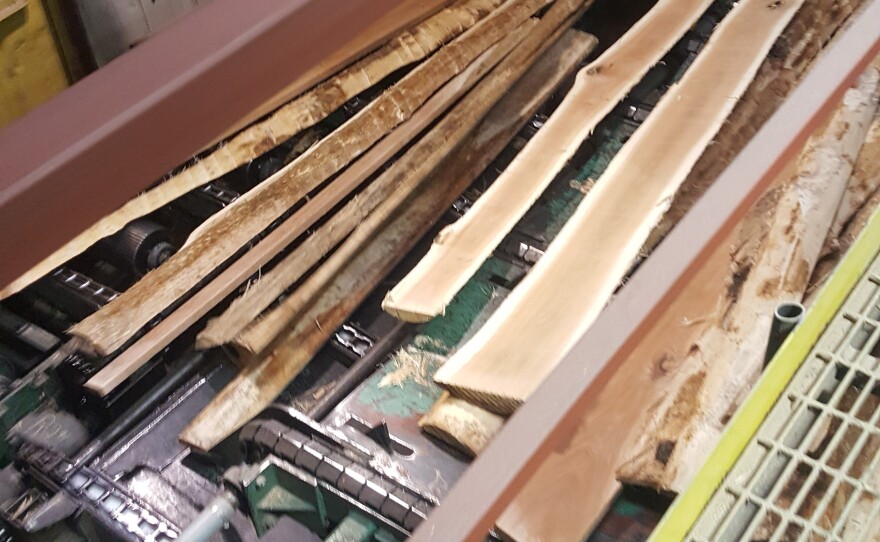Grayling is among the most prominent wood markets in the state. It’s home to 13 companies involved in the manufacturing of wood products. These companies account for roughly 850 jobs now, and another 200 more when a new plant opens next year.
Today our On the Map series brings us to a small northern city where Michigan trees are transformed into boards, planks and other components most commonly used for furniture and housing.
Since its founding, Grayling has been ground zero for wood mills. It’s located near two rivers and that made it relatively easy to harvest and ship trees. Even today Grayling is home to one of the largest wood manufacturing markets in Michigan.
Other communities in the state have a strong wood manufacturing presence, think for example the UP, but Grayling is unique because it has several large plants that neighbor and complement each other.
My first stop for this on the map visit was AJD Forest Products. It’s one of the oldest wood plants in Grayling. It’s 43 years old and employs 65 people.
When I first arrived, I was astonished by how efficiently they use the lumber. I spoke with Tim Neff, the General Manager of the plant. He says virtually nothing goes to waste.
“Everything in the industry is utilized. For our mill the logs come in, we break them down make the products that we need, 100 percent of the sawdust goes to the power plant to generate electricity. The bark is purchased for mulch, landscapers, orchards, nurseries we have a lot of nursery customers that use the bark for root stock around their trees and shrubs. The wood chips either go to engineered wood product plants and what we don’t send there we can send over to the power plant again to be used for fuel. So nothing that comes onto our facility isn’t sold or used in some capacity.”
Anything that isn’t sent to other mills or to the neighboring power plant goes to the other wood plants in Grayling. Like I said before, they complement each other.
I wondered with so many wood plants in one area is there a turf battle for trees? Neff said that’s not a problem.
Some of the wood manufacturers in the area use hardwoods, others use softer woods, and some use both. Neff says there is usually plenty of wood to go around.
“There’s competition, there’s an abundance of the resource, but the landowners be the state of Michigan, the federal government or private landowners of course want to maximize their economic value of whatever their management plan is. So yeah the competition is in acquiring the timber but it’s not a question of resource availability it’s out there it’s just competitive bidding.”
The next big wood manufacturer in the area will be Arauco, which is expected to be operational in the fall of 2018.
Brian Sarginson is Director of Strategic Projects for Arauco North America. He says there are a number of reasons Arauco chose Grayling for their new location.
“There are four pulp mills either that were located immediately in the region or hauled wood from the region that have closed over the last ten years so a real opportunity. Growth in that area is far exceeding the volume of material that’s being harvested.”
Sarginson says a big factor was Grayling’s location within the state.
“I think when you take a look at the geography there, drew a circle of the actual forest itself, Grayling probably is a chosen site because it rather sits in the middle of that circle and if you position yourself completely to the left side or the right you increase your average hauling distance for your raw material.”
Sarginson says while there is competition for raw materials, much of the real battle is for skilled workers.
Tom Quinn is the President of Kirtland Community College. It’s working to provide the industry with more skilled workers. He says the lumber industry today is not your grandfather's lumber industry.
“It’s adding on a new facility here, I’m going to call it a training center for wood products industries and wood technology and automation of forest products manufacturing plants, because it’s full of lasers and sensors and instrumentations and all kinds of things that are totally amazing to people when you watch that.”
Quinn says the wood industry in Grayling plays a big role in the economy. It accounts for nearly a thousand jobs in the area. With the industry growing and technology progressing, he wants to provide more skilled workers.
“Our research shows that, I’m going to exaggerate a slight bit but in the eleven counties in northeast Michigan here about a quarter of all jobs are in Grayling.”
When Grayling was founded in 1882, it was supported by wood manufacturers and producers. Its central location along with the AuSable and Upper Manistee Rivers providing historical float routes made the community a perfect hub for wood products.
Now with Arauco bringing 200 more jobs, and Kirtland Community College bringing more skilled workers, wood manufacturing will not only continue to better Grayling’s economy, but also put Grayling, Michigan, On the Map.






